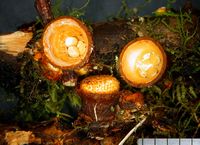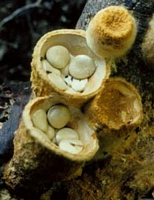|
 Crucibulum laeve Crucibulum laeve
SynonymsCrucibulum vulgare
Cyathus laevis
Crucibulum simile
BiostatusPresent in region - Indigenous. Non endemic
Images (click to enlarge)
Owner: J.A. Cooper | 
Caption: Crucibulum laeve
Owner: Kaimai Bush | 
Caption: fruitbody showing eggs and attachment strand
Owner: J.A. Cooper | 
Caption: Watercolour
Owner: G.M. Taylor | 
Caption: Peridium of Crucibulum vulgare x10. | 
Caption: Crucibulum vulgare. x1 | 
Caption: Fig. 3. Crucibulum vulgare. Spores (x700). | 
Owner: Herb. PDD | |
Article: Cunningham, G.H. (1944). The Gasteromycetes of Australia and New Zealand 236 p. Dunedin: John McIndoe.
Description: Peridium cyathiform, to 12 mm. tall, and 10 mm. diameter at the apex, tapering slightly
to the sessile truncate base, seated on a basal subiculum, exterior bright cinnamon brown,
becoming dingy with age, in young specimens closely covered with appressed silky
tomentum, becoming almost smooth with age, interior pallid cinnamon, smooth, shining;
margin erect, or slightly expanded, even, thick, entire, wall of a single layer of woven
hyphe. Peridiola pallid brown or dingy white, lenticular, orbicular, smooth, 1.25-2 mm.
diameter; wall of three layers, an outer of woven ferruginous hyphae, a middle layer of
deeply coloured branched hyphae, and an inner thin layer of gelatinized hyaline hyphae.
Spores elliptical, rounded at both ends, 7-10 x 4-5.5 µ, epispore hyaline, smooth, 1 µ
thick.
Distribution: DiSTRIBUTION : World-wide. New South. Wales: Orange (1). Victoria: Craigie;
Myperfeld National Reserve; Kollista (4). South Australia: The Hermitage; Mt. Lofty;
Baker's Gully, near Clarendon; Kinchina (1). Western Australia: Pemberton (1).
Tasmania: Hobart (3). New Zealand: Auckland-Puhi Puhi ; Te Aroha ; Mt. Tongariro.
Taranaki-Mt. Egmont. Wellington-Levin Sandhills ; Lake Papaetonga ; York Bay;
Pahiatua ; Komako ; Mt. Ruapehu, track to Ohakune Hut; Manawatu Gorge; Paekakarikei
Forest Reserve; Mangahao, Tararua Ranges; Tiritea ; Teranikau Valley. Westland-Maruia
Track. Canterbury-Cass; Otira Gorge. Otago-Dunedin Town Belt (2).
Notes: The species is the most abundant of those present in the order, and may be collected at
almost any season of the year on dead twigs, fern fronds and the like lying on the forest
floor. Our collections agree exactly with European and North American specimens. There
is also present in this region a small form which was named C.simile Mass. Through the
courtesy of Miss Wakefield I have been able to examine part of the type, collected at
Dannevirke by Colenso and now in Kew herbarium, No. 414. It agrees with other small
specimens, differing from C.vulgare only in the smaller size of the peridia and peridiola.
So many intermediate forms occur that separation is not practicable. The spores are as
given above, not 4 x 3 µ as described by Massee.
Since the brothers Tulasne published their classical monograph most workers have
accepted their specific names for members of the family, as they were the first to work
over the old European forms critically and bring order out of the chaotic naming of
earlier workers. Certain American workers have, however, on the plea of priority,
recorded the species under the names of Crucibulum crucibuliforme and C.levis. The
former cannot be used since the specific name was employed by Scopoli prior to the
starting point of modern nomenclature. No evidence exists that the plant named Cyathus
levis by De Candolle is the same as C.vulgare. Use of the combination Crucibulum
crucibulum, which has also been proposed on the score that the specific name was
employed by Persoon, is opposed to standard usage and the recommendations of the
International Rules of Nomenclature.
Article: Cooke, M.C. (1879). New Zealand fungi. Grevillea 8(46): 54-68.
|